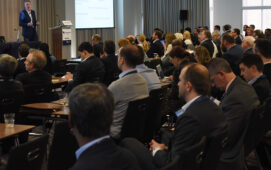Plenty of food for thought this week for those of us who need to think deeply about latency. No, A-Team isn’t wrestling with how to squeeze out interparty latency, cut the tails of its jitter curves or ensure ROI on new high-speed venue connections (although we know many of you are).
No, our current deep thinking is around latency of execution platforms, which is starting to emerge as a differentiator in exchanges’ marketing pitches. Which is how we came up with the idea in the first place for the Top 10 fastest venues by platform latency, which we’ll be adding to Low-Latency.com as we gear up for its relaunch at our Business & Technology of Low-Latency Trading events in London on April 19 and New York on April 28.
Now, before we get shot down in a hail of low-latency bullets, we know that it’s very tricky (read: impossible) to come up with a true ranking by real-life trade-matching latency. Indeed, our own Peter Harris has threatened to blog on how a realistic latency ranking isn’t possible to achieve (and we look forward to reading that). But we can rank platform latency by publicly stated average matching latency rates. And that’s what we plan to do.
Sounds simple? Maybe, but – perhaps encouragingly – it’s a fast moving target. Since we started collating the data behind our Top 10 list, we’ve been inundated by potentially rank-impacting changes. How to rank the London Stock Exchange, for example, whose off-again, on-again deployment of the Millennium Exchange platform for both its Turquoise and main markets underscores the importance of timing? The latest on that, by the way, is that testing will begin on January 24, with dress rehearsals on January 29 and February 5. Connectivity testing starts on February 12, culminating in a new live date on Valentine’s Day.
And how about Plus Markets, whose plans to implement Algo Technologies’ new matching engine – tipped as the world’s fastest – could make it the fastest European marketplace, but may yet be some months away from production? And how to handle this week’s news of the Singapore Exchange’s intention to introduce what it reckons will be the world’s fastest matching engine – at 90 microseconds turnaround time – on August 15.
The answer is that our Top 10 list will rank only platforms in production and being used to operate markets on a daily basis. Still, there’s complexity as the big market operators – take Nasdaq OMX or NYSE Euronext – deploy new, ever-faster platforms in support of their growing number of venues. As a result, we expect to be our list to be a ‘living document’, so we’ll be issuing updates to it as they emerge. If you think your marketplace, or your client’s marketplace, should be on the list, please get in touch pronto.
Meanwhile, more food for thought – as well as lots of very nice champagne and wine – was served up at this week’s FutureCity event, courtesy of Nigel Woodward, formerly of Intel, and the nice people at Chief Wine Officer. Over rounds of bubbly, white and red, the great and the good of the London Low Latency community were treated to a series of educational presentations and discussions from sponsors, including NYSE Technologies, Bats Europe, Dell, TS-Associates, Solarflare, Sybase-SAS, Voltaire, Rapid Addition and Intel. Some highlights from the evening:
- NYSE Technologies’ Ian Jack revealed that Goldman Sachs’ planned Sigma MTF will be the first non-NYSE Euronext marketplace to be hosted at the new Liquidity Hub in Basildon. It’s all part of NYSE’s plan to open up its 300,000 square foot facility to both buy-side firms and venue operators.
- Bats Europe’s Clem Marsh pointed out that the European equity market is just a quarter of the size of the US’s, all because of a raft of ‘friction’ points, including the lack of a common symbology and standard tick sizes, high costs of clearing and settlement, and – Bats’ particular bugbear – the absence of a consolidated tape. Top venues in the US: Nasdaq, NYSE Arca, NYSE floor, Bats, DirectEdge. Top venues in Europe: London Stock Exchange, NYSE Euronext, Deutsche Boerse, followed by other domestic European exchanges as a group, Chi-X Europe and Bats Europe.
- Mark Reece of HSBC – wearing his FIX Protocol High Frequency Trading Working Group chair hat – offered a fascinating discussion of things to consider as you prioritise your latency-reduction efforts. Reece demonstrated, for instance, how one trader with a faster, but more jitter-prone trading infrastructure might only marginally outperform another with a slow but more reliable low-latency set-up. Reece emphasised the need for constant latency measurement to identify areas of potential improvement.
- Dell’s Peters Barnes and Hubbard lifted the lid on the hush-hush Trading Machine, based on Dell’s standard PowerEdge R710 “E” server and Intel’s Everest 4.4 gigaHertz dual core chip. The Peters reckon this server can run 30%, 40%, 50% faster than current offerings, with no power, heat or density issues. It’s in tests currently with customers in New York and London.
- Thematic Capital’s Ken Yeadon warned of the potential of ‘latency on latency reporting’ as venues’ latency considerations are factored into market practitioners’ trading decisions. Think about it. Bank of America Merrill Lynch’s Rupert Brown had pointed out that as the industry moves toward microsecond measurement, the volume of measurements will increase significantly.
Henry Young of TS-Associates – with his FPL Interparty Latency Working Group hat on – said an early version of a new standard protocol is just “a couple of weeks away.” Young also pointed out the importance of that final cable connection: “One nanosecond is about 30 centimetres and there’s a very large building in Basildon.” So there is.
Subscribe to our newsletter




